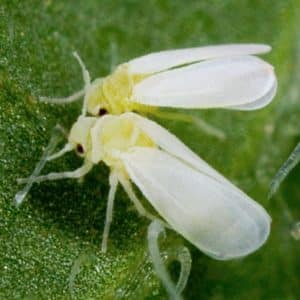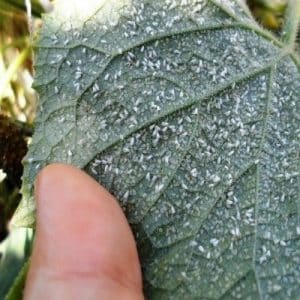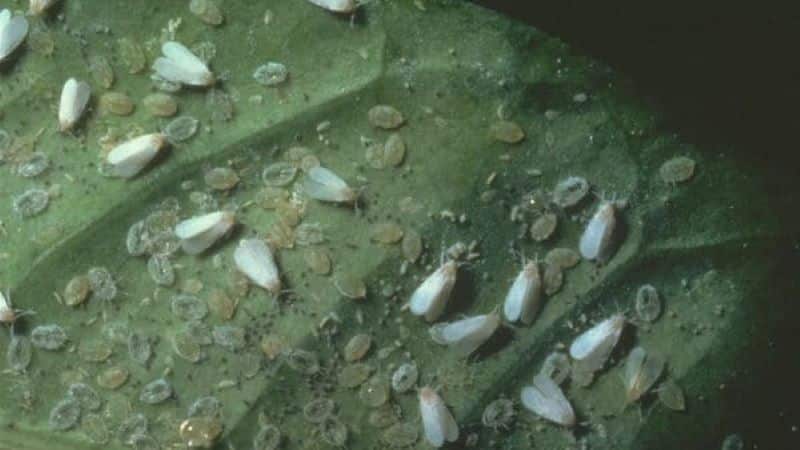How to get rid of whiteflies in a greenhouse on cucumbers: the most effective methods of control and prevention
Cucumbers are often subjected to pest attacks. The succulent leaves of this crop attract various insects. One of them is the whitefly, or white midge.
Whitefly in a greenhouse on cucumbers is a common problem for gardeners. What to do, how to get rid of it? Let's figure it out together.
What kind of pest is this
Whitefly, or white midge, is a dangerous pest. The insect feeds on plant sap and reproduces very quickly. The whitefly and its larvae usually settle on the lower surface of the leaf.
Often the insect appears in greenhouses, as it loves a warm and humid climate. Lives on plants in groups.
Appearance

Whiteflies (pictured) are small moth-like insects with milky white wings and a white or yellow body. They reach no more than 3 mm in length. They have 4 wings, covered with a white coating reminiscent of flour.
Whitefly larvae are small, up to 0.3 mm in size. They look like translucent yellow scales. Having hatched from the egg, they attach themselves to the leaf and begin to actively feed on its juice.
Later comes the pupal stage. At this time, the larva is maximally resistant to various drugs. Then an adult with wings emerges from the pupa, which is capable of flying to other plants and reproducing.
Symptoms of cucumber damage
Due to the fact that whiteflies live on the underside of leaves, they may not be noticed immediately. It is necessary to systematically inspect cucumbers and know the signs by which whitefly infestation is determined:
- the surface of the stems and leaves becomes sticky and covered with a white coating;
- the leaves curl, fade, wither;
- yellow or green spots with blurred boundaries appear on the leaves;
- larvae are visible on the inside of the leaf;
- over time, a black coating appears - sooty fungus (such an infected plant is dug up and burned);
- The development of the vegetable slows down noticeably and the yield decreases;
- if you shake cucumbers, a swarm of white midges rises into the air - these are whiteflies.
If at least one of the listed signs is detected, it is necessary to urgently take measures to combat the pest.
Damage caused
Since the insect feeds on plant juices, affected cucumbers begin to lag behind healthy ones in development. Their leaves dry out and fall off over time, and subsequently the entire crop withers.
Due to lack of fluid, the ovaries cannot fill and fully ripen. This leads to a sharp decrease in yield.
The white midge carries diseases such as jaundice, yellow mosaic, chlorosis, leaf curl and fruit necrosis. In places where the whitefly drank the juice and left its excess, chlorophyll is not formed and various pathogenic microorganisms develop.
How to deal with whitefly on cucumbers in a greenhouse
As soon as you notice the first signs of pests appearing in the greenhouse, immediately take measures to destroy them. First, try mechanical methods of removing whiteflies from a bush:
- Collect the insect by hand with a sponge dipped in soapy water.
- Remove and burn the leaves on which the larvae have settled. It makes sense to remove leaves if the plant is slightly damaged. If the whitefly has occupied more than 40% of the cucumbers, this method will not work.
- Wash off the insects from the bush with strong water pressure from a hose, and then treat the leaves with a soapy solution.
- Collect adult insects with a hand-held vacuum cleaner.
These are only temporary measures that are not capable of destroying insects completely, but can significantly reduce their number before further struggle.
There are various ways to combat whiteflies: mechanical traps, traditional methods, biological agents and chemicals.
It is better to get rid of insects using chemicals at the last moment, if other tried means have not given the desired result.
Mechanical traps
Traps for whiteflies can be bought in specialized stores or made with your own hands:
- Paint a plastic bottle orange, cover the outside with a layer of sticky glue or a mixture of Vaseline and laundry soap (1:1). Light it from the inside and hang it in the greenhouse at the growth level of the cucumber bushes. The midges will fly to the light and stick to the surface of the trap.
- Place a light bulb with a red or orange light in a small wooden box (or paint a regular light bulb). Hang the structure in the greenhouse and place a container of water under it. Whiteflies will fly into the light, get burned by the light bulb and fall into the water.
Reference. Such traps are capable of exterminating up to 80% of adult pests in a greenhouse.
Traditional methods
Gardeners who encounter whiteflies on cucumbers are always interested in how to treat the plants against the pest without resorting to chemicals. For such purposes, there are folk recipes against white midges:
- Soap solution. To spray and wipe the leaves, use laundry or tar soap. It is mixed with water in a ratio of 6:1.
- Sugar solution. 100 g of sugar is dissolved in 400 ml of water. The mixture is treated with infected leaves. If the remedy does not help the first time, repeat the procedure after a week. 5 days after treatment, thoroughly wash the leaves to remove the sugar film.
- Lemon infusion. 100 g of lemon peels are poured into 1 liter of water for 24 hours. Add 60 g of soap. After this, the infected leaves are sprayed with a solution from a spray bottle.
- Garlic infusion. Finely chop 300 g of garlic cloves and fill them with 1 liter of water. Leave in a dark place for 5 days. Then 5 g of the resulting solution is again diluted in 1 liter of clean water. Spraying is done using a spray bottle.
- Dandelion infusion. 80 g of dandelion leaves and roots are poured into 1 liter of water and left for about 4 hours. After this, the solution is filtered and the infected leaves are sprayed with it.
- Infusion of yarrow. Add 100 g of yarrow herb to 1 liter of water and leave for 2 days in a dark place. Then the infusion is filtered and the cucumber beds are treated with it.
Biological agents
An interesting biological way to exterminate whiteflies is to include other insects in the fight against it. In nature, white midges and their larvae are hunted by, for example, ladybugs and lacewings. To attract them, marigolds are planted next to cucumbers.
There is also an insect in nature that parasitizes whitefly larvae. This is an encarzia - an ichneumon rider from the order Hymenoptera. She lays her eggs directly into the white midge larvae, thereby destroying them. Insects are populated in the greenhouse at the rate of 20 individuals per 1 m2.
Important! Villi on the leaves of cucumbers prevent encarsia from reaching the whitefly larvae, so this method may not work to its full potential on this particular crop.
The biological preparation "Verticillin" contains a fungus that can kill both larvae and adult whiteflies. At the same time, it does not cause any harm to plants, animals and humans. The drug “Fitoverm” will also help in the fight against pests.
Chemicals
If the previous methods did not help or the whitefly infestation has reached significant proportions, you will have to resort to chemical means.
The most effective insecticides against whiteflies include:
- «Aktellik" Sold in ampoules. The contents of one ampoule (2 ml) are dissolved in 2 liters of water and sprayed. Up to 2 treatments are allowed. Protective effect in a greenhouse is 10–12 days.
- «Arrivo" Consumption rate: 1.5 ml per 10 liters of water. Protective effect - 10–14 days.
- "Bona Forte"(insecticide). The contents of the ampoule (2 ml) are dissolved in 0.5 l of water. Valid for 2-3 weeks.
- "Inta-Vir". 1 tablet per 10 liters of water. Up to 3 treatments.
- «Spark" First, ½ tablet is completely dissolved in a small amount of water, then diluted with water to 5 liters. Repeated spraying is possible after 20 days.
- «Confidor" 1 ml per 5–10 liters of water. Protective effect - 15–30 days.
- «Talstar" 0.6 ml per 1 liter of water. Protects the culture for 2-3 weeks.
- «Tanrek" 5 ml per 10 liters of water. Pour 1 liter of liquid into a plastic bucket, add 5 ml of the drug, mix, dilute to 10 liters. The effect lasts up to 4 weeks.
- «Fas"(insecticide). ½ tablet per 5 liters of water. The interval between treatments is 15–20 days.
- «Fufanon" 13 ml per 10 liters of water. Protective effect – 5–10 days.
You can eat fruits after treating cucumbers with chemicals only after a month. In the case of biological products - after 2-3 days. Diluted chemicals cannot be stored.
Important! When handling chemicals, wear a respirator. Make sure that the drug does not come into contact with exposed skin. It is better to throw away gloves after use. Wash your hands, face and eyes with soap.
Most insecticides repel all insects, including bees, so cucumbers should not be treated with them during the flowering period.
Features of wrestling in open ground
In open ground, whitefly infection most often occurs through seedlings. Before planting, carefully inspect the seedlings for insects or signs of their presence.
To prevent infection of cucumbers in the garden or plot, the “Bud” product is suitable. Dilute 10 g of the drug in 10 liters of water and spray vegetables every 10 days.
 If you find whiteflies on cucumbers in open ground, first wash them off with water and loosen the top 2 cm of soil. Then treat the plant several times with a soap solution and insecticide. Iskra is well suited for these purposes.
If you find whiteflies on cucumbers in open ground, first wash them off with water and loosen the top 2 cm of soil. Then treat the plant several times with a soap solution and insecticide. Iskra is well suited for these purposes.
Spraying should be carried out in dry, windless weather, in the morning (before 10:00) or evening (after 18:00), when the plants are not at risk of sunburn.
Preventive measures
To prevent the appearance of whiteflies on cucumbers in a greenhouse, a number of rules should be followed:
- Use traps. A bright surface will attract insects, and a sticky surface will prevent them from escaping.
- Experienced gardeners recommend using the “Bud” product for prevention.
- Carefully inspect the seedlings before planting in the ground. Purchase seedlings only from trusted manufacturers. Check the leaves before purchasing.
- After harvesting, carefully dig up the soil and remove all plant debris and debris.
- Treat the soil with bleach or copper sulfate. Fumigate the greenhouse with tobacco smoke. Treat the frames with Bordeaux mixture.
- Freeze the greenhouse in winter: open it for 1-2 days when the temperature drops below -12...-15 °C. In such conditions, insects die.
- Do not plant plants very densely and avoid extreme heat and humidity in the greenhouse. You can stretch a gauze mesh over the windows in the greenhouse.
Don’t be lazy to carry out prevention, and then the whitefly will not be scary for your cucumbers.
Reviews
All these methods have been repeatedly tested by gardeners who have at least once fought against whiteflies. Not every method bears fruit, and sometimes new solutions appear that unexpectedly lead to victory.
Galina, Kazan: «What if you use a sulfur bomb to treat the greenhouse? Every autumn I light 3 checkers at the same time (I have a large greenhouse). And in the summer I make tobacco smoke in the greenhouse - it doesn’t harm the plants, but the effect is excellent! There are no whiteflies..."
Tatyana, Voronezh region: “Last year I was in a greenhouse in the summer and couldn’t destroy it. In winter I kept the greenhouse without snow; I added snow only in February. I didn’t see it in the greenhouse this summer. So it’s not all that bad.”
Natalya, Perm: “I only had whitefly in the first year of my gardening. Then I started hanging up bottles of iodine - there were no pests or late blight.”
Margarita, Tyumen: “I am militantly determined for the summer of 2018! I've been on the warpath since the fall! First of all, I treated the diseased (and not only) bushes behind closed doors. The next day I dug up all the bushes, took them far beyond the site and burned them! I dug up the ridges when it got cold and didn’t cover them with snow.I wanted to freeze this disgusting thing, but it’s not for nothing that they say - be afraid of your wishes! The winter turned out to be fierce: 10–15 centimeters of snow fell during the entire winter, and the frost was -50! Not only the whitefly froze - 90% of the perennial flowers, almost all the vegetables in the cellar. So I won this war at the cost of great losses, but there were no whiteflies in my greenhouse in the summer of 2018!”
Yuri, Chelyabinsk: “I struggled for six months, all to no avail, nothing helps. The fumigator (Transflutrin liquid) unexpectedly helped. All those flying died within a day. It does not affect larvae and eggs, you need to wait until the butterflies hatch. We close the greenhouse tightly, turn on the fumigator in the evening (at night), turn it off in the morning, repeat every other day, and so on for a month (preferably two). The effect is 100%."
Read also:
How to cook pickled cucumbers in a bag quickly and tasty.
Why are cucumbers bitter, how to prevent it and what to do with the harvest.
How to prepare delicious pickled cucumbers with grape vinegar.
Conclusion
Getting rid of whiteflies is a labor-intensive process. When infected, it is important to start fighting it as early as possible. This insect reproduces at a high speed, and once it has infested an entire area or greenhouse, it is simply impossible to get rid of it.
When working with chemicals, be sure to read the instructions, follow them carefully, and take precautions. Do not neglect preventative measures against whiteflies. This is the easiest way to save the harvest. Don't wait for small bugs to appear on cucumbers.